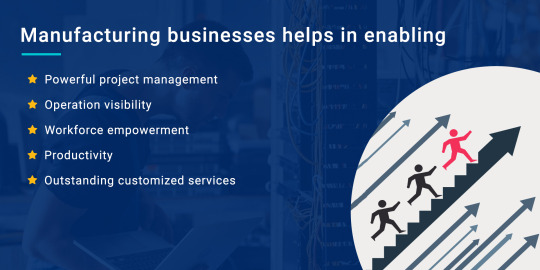Text

Microsoft Dynamics 365 Business Central is a powerful enterprise resource planning (ERP) solution offered by Microsoft. It streamlines business operations, enhances productivity, and provides valuable insights for informed decision-making. With Dynamics Business Central, organizations can efficiently manage their finances, supply chain, and customer relationships, making it a valuable tool for modern businesses.
#microsoft dynamics 365 business central#business central#dynamics 365 business central#microsoft business central#dynamics business central#enterprise resource planning#erp enterprise resource planning#enterprise erp systems#cloud enterprise resource planning#erp resource planning#erp in management information system
0 notes
Text

Explore our comprehensive APMP certification training program to enhance your project management skills. Join our APMP training courses and elevate your expertise in project management. Enroll in APMP training to boost your career prospects and excel in project management.
#APMP Certification Training#APMP Training#APMP Training Courses#APMP Certification#APMP Foundation Certification#APMP Foundation Course
0 notes
Text
Improve your business processes and customer relationships with Microsoft Dynamics CRM. Learn about its features and benefits in our informative blog post.
0 notes
Text
Improve your business processes and customer relationships with Microsoft Dynamics CRM. Learn about its features and benefits in our informative blog post.
0 notes
Text
Learn the key factors to consider before choosing an ERP system. From scalability to customization, get expert advice to make the right decision for your business. Read on for a comprehensive guide.
0 notes
Text

Revenue Leakage in Projects - Welcome to Centredge
We help in managing end-to-end projects, taking bottom-line responsibility of delivery, implementing and hand holding agile, reporting and work as a bridge between product SMEs, developers and testers.
0 notes
Text

Integration of ERP with the Internet of Things - Centredge
Integrating your ERP with the internet of things can help you to achieve better business heights. Read our blog and Find out what they are now.
0 notes
Text

What is Bid and Proposal Management | Centredge Services
Bids and Proposals are part and parcel of any industry to grow. Find out What is Bid and Proposal Management & roles and responsibilities in a bid and proposal management in our blog.
0 notes
Text

Microsoft Dynamics 365 in Manufacturing | Centredge
Digital transformation is a game-changer in the manufacturing industry. Learn how Microsoft Dynamics 365 benefits manufacturers to stay competitive and reduce time to market.
0 notes
Text

Do Start-ups Need a Project Management Office? - Welcome to Centredge
We help in managing end-to-end projects, taking bottom-line responsibility of delivery, implementing and hand holding agile, reporting and work as a bridge between product SMEs, developers and testers.
#project management services#agile implementation services#power platform services#proposal management#Project Management Office
0 notes
Text

Account Mining – A Manager’s Perspective - Welcome to Centredge
We help in managing end-to-end projects, taking bottom-line responsibility of delivery, implementing and hand holding agile, reporting and work as a bridge between product SMEs, developers and testers.
0 notes
Text
Microsoft Dynamics 365 in Manufacturing | Centredge

What is an ERP?
Enterprise Resource Planning or ERP is nothing but a software system helping organizations automate and manage their fundamental business processes for the best performance. A cloud ERP solution helps in coordinating data flow between an organization’s processes, offering the only basis of truth and modernizing operations throughout the enterprise. It can connect a company’s operations, financials, commerce, supply chain, manufacturing, reporting, as well as human resource tasks on one platform.
When it comes to an industry like manufacturing, where competence is continuously sought but challenging to find, ERP could be the game-changer. ERP in manufacturing is a centralized technique of handling all aspects of processes and operations, right from production to payroll. An ERP system lets unparalleled visibility, synchronization, and administration across different business processes, eventually resulting in enhanced operational efficiency.
Five Major Challenges in the Manufacturing Industry
The manufacturing sector is rife with challenges, more so since the pandemic and other factors such as tariffs, political reforms, climate changes, and more. However, the manufacturing industry is quite positive concerning the future with the expected industrial production to shoot up by 5 percent in 2022. Though this is an optimistic prediction, manufacturing firms experiencing growth still have some key challenges in the days to come. Here are the five major ones:
1. Shortage of Labor
Even when manufacturing firms have availability of product raw materials, they do not have sufficient time to build them. Since the COVID-19 outbreak, activities related to shift-based work dipped significantly by over 13 percent, and over 50 percent of American manufacturing businesses affirm that they are finding it difficult to find skilled workers.
There is a need to update facilities with a hi-tech working environment, technological capabilities, comfortable amenities, and break rooms for attracting as well as retaining skilled labor.
2. Disturbance in Supply Chain
Disruptions in the supply chain are one of the greatest challenges in the manufacturing industry. Inventories are at the poorest levels in years, implying a few products just can’t be manufactured. Due to limited inventories, the supply chain in manufacturing has become susceptible to uncertainty. Businesses having financial earnings are focusing on stocking up inventories, increasing demand for additional warehouse space, and reaping the maximum advantages of ERP in supply chain management.
3. Safety of Workers
Manufacturing businesses are extremely aware of preventing accidents and protecting their staff from possible health hazards in the facility. Assuring physical well-being and safety from tripping and falling as well as additional OSHA requirements is the top priority.

4. Capacity Restrictions
The requirement for additional space on the production floor is being counterbalanced by a minimized demand for office space. That’s because a few administrative employees continue to work remotely. Several businesses are employing creativity to restructure floor plans, modernize, and invest in additional tech-friendly furnishings to accommodate video calls, virtual meetings, and evolving technologies.
5. Evolving Technologies and Cybersecurity
Manufacturers are trying to overcome labor shortages by leveraging modern technology and making the most out of the benefits of cloud ERP. Again, robotics and IoT (Internet of things) is being used to do certain human tasks in the manufacturing sector. Today, there is new interest in capitalizing more on such emerging technologies.
The pandemic has emphasized the benefits of a good ERP system, cloud, and IoT technology, allowing manufacturing units to implement digital transformation in a business environment. With an increasing number of technological solutions like Microsoft Dynamics 365 and connected devices, there is a requirement for enhanced cybersecurity.
Several manufacturing businesses still function using old or legacy applications, while others completely embraced modern technologies. Both have risks and managing numerous security layers including multi-factor authentication, firewalls, round-the-clock monitoring, facial recognition software, etc. are imperative in the modern digital landscape. Upgrading safe and climate-controlled server rooms are also equally important in shielding sensitive equipment and assuring security.
How Does Microsoft Dynamics 365 Help the Manufacturing Industry?
Even a couple of years ago, manufacturing businesses perceived improving productivity and taking customer satisfaction to the next level in sole isolation. Then, digital disruption is essentially changing the way manufacturers operate or do business, leveraging modern, innovative technology. To be candid, they’re inspiring transformational change throughout the business to enhance product quality, reduce time to market, and meet the changing demands of customers.
Whether it is improving visibility, and efficiency, or cutting back on expenditures, these have been the basic concerns of manufacturing businesses. Fortunately, Dynamics 365 for manufacturing provides profound insights into the supply chain as well as production lifecycles, particulars of warehousing, as well as delivering schedules to meet the challenges.
Businesses processes as a single comprehensive service and apps developed with the purpose ensure seamless access across all functions including sales, finance, supply chain operations, and customer service. You have essential data with the click of a button, enabling enhanced productivity and business success.
There are many benefits of Dynamics 365 for the manufacturing sector. Increasing efficiency, enhancing visibility, and reducing expenses are the major concerns for manufacturers. Dynamics 365 BC incorporates and modernizes all aspects of the manufacturing process including preparing, scheduling, inventory, as well as distribution.
Dynamics 365 helps the manufacturing industry to:

Did you know that over 11 billion tons of huge waste are created globally each year? That’s why a majority of businesses have embraced lean strategies to make their production process more efficient. Here is how Microsoft Dynamics 365 can help in reducing waste:
Avoiding Overproduction: Purchase only the equipment that your manufacturing unit needs and avoid producing more products than it’s possible to sell by exploiting appropriate inventory control, effective management, and precise timelines.
Get rid of waste by leveraging Microsoft Dynamics for Supply Chain Management by integrating manufacturing workflows and adjusting manufacturing schedules. Additionally, the cloud ERP solution will help you achieve waste reduction goals by utilizing automation to push production, and capacity holdings, and developing planned manufacturing strategies to help you realize the costs of all factory activities.
Using Lean Manufacturing: You can remove waste anywhere and every time possible by employing lean manufacturing for every facet of your business. Be it accounting or payroll, you will find numerous ways to employ an organized way for waste reduction in a manufacturing system without compromising productivity.
Dynamics 365 lets you modernize all business processes as well as helps you track the complete production process of any product or service. D365 is integrated software that helps you to build a factory comprising extraordinary efficiency levels and the removal of activities that don’t add value to your manufacturing business.
Upholding Perspective: You need to uphold customer satisfaction by setting definite goals and strategies to steer your business via a shared objective. Dynamics 365 helps in ensuring that every employee is part of a unified team via:
Effective communication
Data analytics in real-time
Joint productive efforts
Through this collective goal, manufacturers can boost profits by ensuring outstanding customer satisfaction. You can do this by focusing on tasks that add more value from the customer’s viewpoint. For instance, you can increase the competitiveness of your business by cutting down costs for your customers. Improve product value, workforce efficiency, sales, and customer satisfaction by harmonizing customer perception and lean manufacturing techniques.
Enhance Productivity
When it comes to productivity, it’s not simply about producing more but about adding more value to the production process. Manufacturing productivity means having a unified understanding of operations as well as access to virtual reality tools and mobile to monitor and work out problems remotely. When technicians can logically manage tasks and make the most of existing skills, enhanced productivity is achievable with costly activities reduced.

@Designers – Pls customize the image. Source: Microsoft
Better Utilization of Manpower
Based on the findings of the International Labor Organization:
2.3 million men and women around the globe give in to occupational accidents or illnesses each year. It corresponds to more than 6000 deaths daily.
Globally, workplace-related accidents are approximately 340 million, and another 160 million when it comes to occupational illnesses.
When your staff is empowered with precise tools and accurate data, the efficiency of daily activities could be improved. Here is how:
Dynamics 365 helps manufacturers enable intelligent and relevant skills-oriented assignments with resource visibility in real-time.
It could be achieved by employing a scheduling engine, gauging manpower utilization precisely, and making smart, informed decisions to reap the maximum benefits from billable resources.
Microsoft Dynamics 365 gives access to role-based tools together with a 360-degree view of your organization. Such tools help in bringing out the best in your employees. This way, you can enable outstanding experiences across:
Employee engagement
Attraction, skill development
Retention
Motivating the workforce to do their best with constant feedback and collective assessments assists in offering personalized services to your customers.
Track and Reduce Accidents
Trips and slips are the mostly occurring causes of workplace injuries. They result in more than one-third of major accidents or injuries, leading to other forms of accidents like falling from a height or falling into manufacturing machinery.
Trips and slips also amount to 50 percent of all reported injuries of the public in their place of work.
Fortunately, there are some plugins with Microsoft Dynamics 365 which can help us to log and track various accidents and help to understand the trends. The Safety Management helps the safety and quality team within D365, providing a structured area in the business system to document factory accidents or sickness.
Essential data related to the worker, accident, injury, or the type of illness, (for example, a broken arm), the type of medical treatment, body part injured, or data related to physician referrals, are all documented. You can also find an audit trail of the place where the accident occurred, the incident cause, and any preventive measures that were ensured to help in the precise documentation of situations.
To monitor trends and ensure a continuous record of worker-specific incidents, injuries, or ailments, the employee data in Dynamics 365 offers a sequential record of all events for auditing. All of this will help in reducing accidents in the future.
Make Business Competitive
In this digital age of manufacturing, businesses require to work smarter and faster to stay competitive in 2022 and ahead. Microsoft Dynamics 365 bridges the gap between ERP and CRM systems, providing manufacturers with robust tools they require to enhance their speed of operations as well as launch improved products faster than their nearest competitors.
By the unification of numerous aspects across the production lifecycle, D365 increases the required capabilities with robust analytics, convenience, and embedded intelligence that you expect from smart apps on your mobile or tablet. When it comes to digital transformation, it can’t be achieved in a day or two. Therefore, you need to make the best of a unified system such as Dynamics 365 for enhanced manufacturing excellence. Manufacturing businesses helps in enabling:
Powerful project management
Operation visibility
Workforce empowerment
Productivity
Outstanding customized services

Microsoft Dynamics 365 makes sense for your business because it brings to the table exemplary customer experiences, helping your manufacturing unit to become more efficient and productive compared to your competitors.
When you have access to data at your fingertips to rediscover and revolutionize, it not only empowers your workforce but also reduces the time to market. Enhanced collaborations during the research and development phase, intelligent evaluations of expenditures and resources, and streamlined manufacturing processes will help you complete new products in little time, and take advantage of the trends and progress. It will help you stay ahead of your closest competitors.
D365 ensures deeper insights into your manufacturing operations, emphasizing areas that have scope for improvement, shortened processes, and cutting down costs. With ERP solutions, you can analyze product, performance, and customer data in real-time to enjoy greater autonomy and opportunity for improving operations and responding to changes fast.
Be Superior to Other Industry Players with Dynamics 365
The power of Azure: D365 is developed on Azure, Microsoft’s prominent cloud service. Let your business reap the benefits of this cloud platform. Save on data storage, improve data security, meet evolving business challenges, enjoy enhanced access and mobile accessibility, experience enhanced collaboration, make informed and intelligent decisions, and deliver high performances to stay competitive.
Flexibility: You can seamlessly manage your core business operations under one roof with Dynamics 365. It includes applications that help you manage finance, sales, customer service, supply chain, and others. D365 applications can be tailored to the specific needs of your business. You can choose modules that are relevant to the business and as the business grows, you can add modules depending on the changing needs.
Find the right kind of customers: D365 assists agents to discover the right customers by leveraging intelligent tools. Get a unified view of your customers and engage with audiences that matter to your business. Microsoft Dynamics 365 also helps in converting leads into loyal customers, giving your employees additional time to engage with customers. Automation works across marketing, sales, and customer service. This way, your teams get more bandwidth to communicate with potential customers and reinforce business relationships.
Final Thoughts
To cope with today’s evolving market requirements and trends, manufacturing businesses need a powerful cloud ERP system connecting internal departments, devices, partners, suppliers, and of course customers in one, simply accessible database. Microsoft Dynamics 365 through its modern collaboration, smart features, and productivity help the manufacturing sector to modernize operations and at the same time improve staff productivity, resource utilization, and customer satisfaction, as well as help in reducing waste.
Merging all business operations across the production cycle into a single all-inclusive service, manufacturing units can gain access to the functions that require to ensure enhanced productivity as well as profitability. And as ERP, cloud, AI, IoT, and mobility create the way to build the future of manufacturing, emerging technologies will not just complement business processes. Such technologies will recommend businesses on how to improve processes while being the actual driving power behind the production floor in the days to come.
Would you want to learn more about CENTREDGE’s ERP solutions and services? We would be delighted to provide a free demonstration of how Dynamics 365 helps you gain a competitive edge over your competitors. Visit our website www.centredge.com or reach us at [email protected] or request a free consultation today.
0 notes
Text
Integration of ERP with the Internet of Things - Centredge

Have you tried integrating your ERP system with the Internet of things (IoT)? In ERP you have all the enterprise data starting from the financials to inventory to manufacturing and HR. What do you do with these data? Data in any organization should be used in the best way to accomplish an insightful business outcome. It should give some actionable vision. There is various analysis that needs to be done, and analytical outputs are given. How does it help?
Some of the quick supportive points for ERP can be:
It gives the leadership a good understanding of where they stand in the market
It gives them an understanding of areas that need to be improved
Focus on maintaining the growth regions
Identify and mitigate business risks
Act before any issues crop up
Decide which business line to venture into next
With ERP systems some of the challenges in Industries went off like:
One version of truth instead of multiple spreadsheets
Complex calculations required for some outcomes are taken care of by ERP
Auto generation of reports and sending to the concerned audience with defined day and time
With the above, let us add IoT for the areas in manufacturing, inventory, shipping, or maybe sales functions. How does IoT increase productivity?
On one side you have all the data for all your transactions happening online or offline or even manual entries in ERP, and on the other side, you are getting instantaneous data from IoT-enabled devices! Amazing, isn’t it?
Some popular use cases for ERP-IoT integrated systems:
IoT-enabled devices monitoring production in a manufacturing unit in real-time by count or weight or any other metric
Updating ERP systems automatically without any manual intervention
Update engineers on the health of the machine by providing the machine logs and an analytical tool on top of it
ABC analysis of inventory and providing real-time status to shop-floor engineers helping them to plan their production batch in ERP or raise alarm in case of risks
Similarly, through IoT a salesperson can understand the availability of products in a nearby warehouse and keep their customers happy by making the correct promise of delivery
Integrating Dynamics 365 Field Service with an IoT platform can help detect and troubleshoot issues, all done remotely!

In short, a proper ERP implementation coupled with an IoT-enabled device will help organizations to get a better understanding and optimize their functions, reduce wastage, and improve profit and cash flow.
Here at Centredge we can help you to achieve both – Implement Microsoft Dynamics(MSD) and implement IoT and integrate with MSD to achieve better business heights. For more details reach out to us – [email protected]
0 notes
Text
Digital transformation is a game-changer in the manufacturing industry. Learn how Microsoft Dynamics 365 benefits manufacturers to stay competitive and reduce time to market.
0 notes
Text
Integrating your ERP with the internet of things can help you to achieve better business heights. Read our blog and Find out what they are now.
0 notes
Text
What is Bid and Proposal Management | Centredge Services

Bids and Proposals are part and parcel of any industry to grow. They are the ones who take an organization from its current position to new heights by dint of adding revenue in the form of new customers. Typically, there is an 8-phase cycle in a business development lifecycle –
Market Identification
Account planning
Opportunity Assessment
Opportunity Planning
Proposal Planning
Proposal Development
Negotiation
Delivery
By definition, a Bid and Proposal is essentially a business plan (proposal) and a proposed cost (bid) for a product or service that is on offer. It is part of the entire business development lifecycle. Let us take an example of a company offering software services. This company will talk about or present its business proposal and associated cost in response to a formal or informal request from its prospective customers. RFP or Request for Proposal is a formal request floated by a customer to announce that there is a project or initiative that needs some contractors to complete. A contractor (in this case the software service provider) on the other hand will understand the RFP and provide a proposal covering the scope, understanding, solution, execution plan, references, and cost for the project. Once the customer evaluates the same and both parties agree on the terms of the project, a deal is signed, and project delivery is executed.
There are various roles that are involved in executing the bid and proposal function. Every organization is unique and hence the job description of bid and proposal manager varies from one company to another. Below are some of the key roles and responsibilities in a bid and proposal management function of an organization.
Bid Manager – A bid manager is someone who takes care of the bid from start to finish – Prebid stage, During Proposal Submission, After Submission, Post bid presentation, Win/Loss of the bid, and finally close the bid with lessons learned. Bid manager is also the one who implements bid management best practices from time to time.
Solution Architect – They take care of all the technical components in a bid and own the same. In many cases, they also play the role of the architects while delivering the projects.
Proposal Writers – Proposal writers are the ones who write the proposal so that the proposal documents are compliant and responsive.
Pricing Manager – Pricing Managers look at how the pricing can be made innovative so that the cost of the project is handled with the profit margin and at the same time it is within the customer’s budget. They also consider the penalties, rewards, and revenue recognition plan while designing the pricing strategy.
Graphics Designer – They beautify the proposal document to make it more interesting and involved. The theme design, the colour, highlights, etc. are planned and represented graphically as well as adding an informative caption it.
Reviewer – The final say on the proposal. They are senior executives in the organization who understand the program and the requirements. They make sure that the requirement given in the proposal is presented in a way that the customer will consider. They review the content, look and feel, pricing, profit margin as well as the graphical representation of the proposal in detail before giving a go-ahead.

A detailed understanding of the Bid and Proposal function and understanding of various roles and responsibilities is available from APMP – Association of Bid and Proposal Management Professionals.
APMP is an internationally accepted organization that helps grow and educate bid and proposal community across the world. They also have chapters in various countries including India (APMPIndia).
APMP also provides 4 certifications that can be taken up based on your career aspirations and job role. Below are the ones from APMP:
Bid/Proposal Foundation Certification
Bid/Proposal Practitioner Certification
Bid/Proposal Professional Certification
Capture Practitioner Certification
Here at Centredge we can help you to get more information about this and also support you in your bid and proposal journey. For more details reach out to us – [email protected]
#bid proposal management services#bid management services#agile implementation#program management services#project management services
0 notes
Text
Bids and Proposals are part and parcel of any industry to grow. Find out What is Bid and Proposal Management & roles and responsibilities in a bid and proposal management in our blog.
0 notes